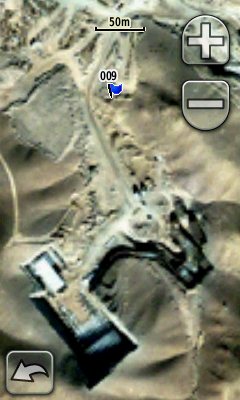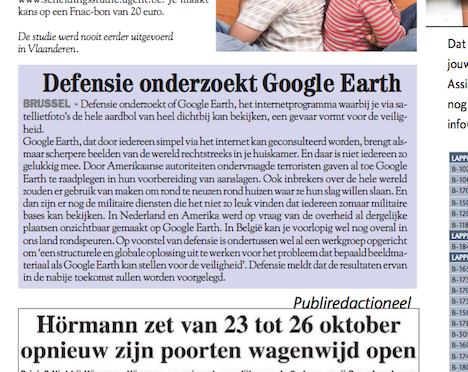-
Satellite images of the Timor Sea oil slick
All posts by Stefan Geens
links for 2009-10-18
-
GPS Visualizer Adds Garmin KMZ Support
links for 2009-10-13
-
Google's post on Random Hacks of Kindness "codejam", with neogeo angle. To be first of many
-
Random Hacks of Kindness disaster relief tech conf Nov 12: MSFT, GOOG, YHOO, World Bank & NASA-Ames sponsor
-
Demo of Bournemouth mapped in 3D with very high resolution lasers. Wow, but I hope it's scalable
Garmin gets support for KML overlays — implications
Late last week Garmin came out with a beta update for its Colorado, Dakota and Oregon GPS devices that displays uploaded KMZ files containing geopositioned overlays. Garmin’s announcement and instructions are here. This is the first time I am aware of that a mobile device renders KML overlays.
GPSTracklog covers the news, and has some usage tips. GPSFix has detailed instructions, tips on using GPS Visualizer’s generated overlays, and an exhaustive list of tools and resources.
I happen to have an Garmin Oregon 300, and since I love it whenever a gadget I own gets better simply by aging, I did the (Windows only) upgrade and some testing myself this past weekend. The verdict:

 Although it is beta, this is a very robust update — the KMZ overlay of satellite imagery from the likely underground nuclear processing plant in IRan blogged a few weeks ago works seamlessly. That’s a 36 megapixel JPEG and a 16 megapixel JPEG in a 11MB combined KMZ file, into which I could zoom to see sub-meter objects! Screen refreshes are obviously not as rapid as on my MacBook Pro, but for a gadget meant to show a position in context it is plenty fast. I was expecting the file to completely bog down the Garmin, but the device didn’t even blink.
Although it is beta, this is a very robust update — the KMZ overlay of satellite imagery from the likely underground nuclear processing plant in IRan blogged a few weeks ago works seamlessly. That’s a 36 megapixel JPEG and a 16 megapixel JPEG in a 11MB combined KMZ file, into which I could zoom to see sub-meter objects! Screen refreshes are obviously not as rapid as on my MacBook Pro, but for a gadget meant to show a position in context it is plenty fast. I was expecting the file to completely bog down the Garmin, but the device didn’t even blink.- Feed the Garmin a KMZ file with mixed KML-based objects, such as placemarks, polygons and overlays, and it wil ignore all the components except for the overlays. No complaining, no error messages. Just the overlays.
Some further thoughts:
- In its instructions, Garmin writes in red ink:
However, please be responsible and only create a Garmin Custom Map from a map that is in the public domain, you hold the copyright in, or you have permission to use from the copyright holder.
I think that statement is a bit odd, and am not at all sure it is justifiable. I understand how the sharing or distribution of maps can require copyright permission, but that is the case for any map, online or offline, digital or paper. What I am having difficulty with in Garmin’s statement is the attempt to parse a difference between owning a map and using a map. As far as I am concerned, owning a map but not being allowed to use it is a nonsensical demand.
To put it another way: Of course I should be able to scan a paper map I own, overlay it in Google Earth and import it into my Garmin. What’s that got to do with the copyright owner?
Sharing the resulting file with an online community? Yes, that could require permission.
But it gets trickier: There are many, many thousands of map and imagery overlays accessible online as KMZ files. In all cases, they have been made available with the expectation that they be displayed on a screen attached to a computer. Until now, the application most likely doing the rendering will have been Google Earth (or possibly Google Maps, or Microsoft Bing), but that is by no means a limitation of the KML markup language. KML is an open standard, and any device is allowed to parse KML. Do any of these KMZ files come with the condition that they may only be viewed using some applications but not others, or may not be viewed in combination with other functionality, such as a GPS positioning function? I think not. So why would it be okay to view such files in Google Earth while running a GPS tracking tool, but not on a Garmin while running its GPS tracking function?
- Why would anyone want to upload KMZ overlays to a Garmin in the first place? There is a very good reason, actually: No other portable device currently supports the display of KML overlays; Google Earth for the iPhone will likely get such support one day, but the iPhone is not an ideal GPS device, because it can only do one thing at a time, and tends to require a connection to the internet. If you’re a nuclear weapons inspector headed for the hills outside Qum, this latest Garmin update is your friend.
links for 2009-10-08
-
Faraz & Jabran, mappers of Pakistan, are making a bigger difference than they imagine
-
CEO Schmidt: Google bought Keyhole for "a few million", he found out after the fact
links for 2009-10-07
-
Animal-powered sensor webs, anyone?
Belgium again thinking of censoring aerial, satellite imagery?
This past Sunday, De Zondag — a Flemish weekend magazine that mostly concerns itself with fashion trends and the lives of soap opera stars — had a curious and tendentious short item entitled “[Belgian] Defense Ministry investigates Google Earth”. The magazine doesn’t even have a proper website, but here is the relevant PDF page, and a translation:

Defense Ministry investigates Google Earth
BRUSSELS — The [Belgian] Defense Ministry is investigating whether Google Earth — the internet application with which you can see the whole world close up through satellite images — forms a threat to security.
Google Earth — which anyone can consult via the internet — brings ever sharper images of the world into the living room, and not everyone is happy with that. Terrorists interrogated by US authorities have already admitted consulting Google Earth in their preparations for attacks. Burglars all over the world are apparently using it to explore the houses they want to rob. And then there are the military institutions that aren’t happy that anyone can just see military bases. In the Netherlands and in the US such places have already been made invisible on Google Earth upon request of the authorities. In Belgium you can currently still explore everything in our country. At the suggestion of the Defense Ministry, a working group has been set up to “develop a structural and global solution to the problem that certain imagery such as that in Google Earth can pose for security.” The Defense Ministry says that the results [of the working group] will be presented shortly.
I found it via a re-reporting in English on Expatica, but lacking any context, and considering the reputation of De Zondag, I let it go.
But then fellow Belgian Henri Willox, who is currently living and tweeting amid “interesting times” in Conakry, Guinea, listed a series of pick-ups of the story in mainstream Belgian and Dutch media, including one of Belgium’s biggest papers, Belgium’s national press agency, all of them uncritically parrotting the copy of the original. That’s when a story like this becomes important, because if left uncorrected, its mistaken assumptions will become received wisdom, both among casual readers and among policymakers. It also contains a dangerous idea.
But first — I am still not convinced that De Zondag has a proper story. It doesn’t look like a leak (if it were, why leak it to De Zondag?) nor was the information first disseminated via a press release or via the national press agency Belga, as the Belgian Defense Ministry tends to do.
But let us assume that it is a real story. It would be another sorry chapter in Belgium’s paranoid official stance towards Google Earth. It began innocently enough in May 2006, when the Defense Ministry issued a statement in which it said it was “not afraid” of the imagery, and that in any case it had been commercially available for years. But then during 2006 Google Earth received more and better quality satellite imagery of Belgium, and then the tune changed: In September 2006 the Belgian military said that yes, actually, it would like to censor its bases after all. But how? Belgium’s senate intelligence oversight committee decided that month to take a look at the legal options, and to report back. (Its own intelligence on Google Earth didn’t seem to be all that good, BTW.) One of the members of the committee was even interviewed by Belgeoblog on the matter. And that was the last of it. If there was a report, it was never publicized. Unlike in the Netherlands, there is no law on the books in Belgium allowing government censorship of aerial imagery before its release into the public domain. (Neither Belgium nor the Netherlands claim jurisdiction over space, so satellite imagery is always immune form such interference.)
In August 2009, Belgium got a remarkable imagery upgrade, from satellite imagery to aerial imagery, taken in April 2007 by the same company that took the Dutch imagery, which was censored by the Dutch government before being released to the public. Might the De Zondag story be a reaction in the Belgian military to this development? It’s possible; Belgian military bases are certainly clearer than ever. But if that is a problem, it is something that needs to be fixed between the Belgian government and the aerial imagery providers operating in its airspace. Google just buys the resulting available imagery.
In other words:
In the Netherlands and in the US such places have already been made invisible on Google Earth upon request of the authorities.
Wrong: In both cases, aerial imagery was censored before it was released to the public domain. What else is wrong in the article?
Terrorists interrogated by US authorities have already admitted consulting Google Earth in their preparations for attacks.
If the article had said “Indian authorities”, it would have been correct. Those same terrorists also used mobile phones and credit cards, however. Is it so surprising that everyone uses these tools for both good and evil? The mention of burglars is similarly hyperbolic.
But the part of that article that worries me is the mention of developing a “structural and global solution” allowing the censorship of tools like Google Earth. I hope that by “global”, Belgian lawmakers merely mean “thorough”. But it could also mean that they think it would be a good idea to change international law, extending the ability of national governments to censor imagery of their respective territories taken by satellite imagery providers. Such an initiative was already mooted once by the Indian government, and no doubt despotic regimes everywhere would sign up for it if given half a chance.